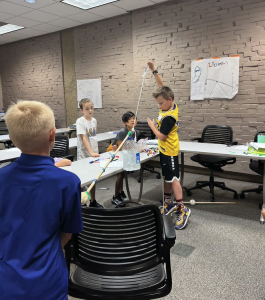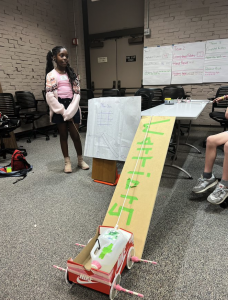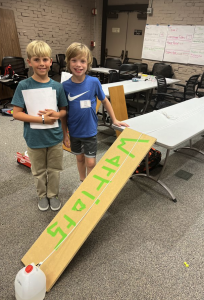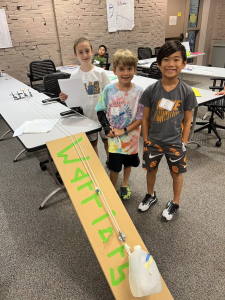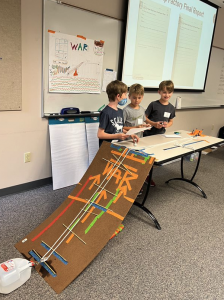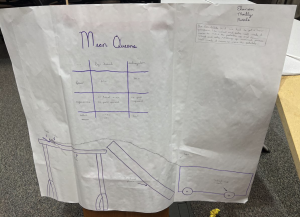Summer SAVY 2022/Session 3 – Industrial Engineering for Rising 3rd/4th Grade
Friday: Good evening SAVY students and parents! Today’s lesson gave students the opportunity to apply what they have learned about simple machines, ergonomics, processes, and the concept and measurement of force as they work to improve a factory subsystem. As students brainstormed design ideas, they were reminded of the information they gathered during Lesson 3 about the trade-offs of using each simple machine and how different simple machines make work easier (by either reducing the amount of force required to move a load or providing an ergonomic advantage to the user). During Lesson 2, students also learned about how processes, such as assembly lines, can be designed to make work easier and more efficient.
The goal of this lesson was for students to engage in the Engineering Design Process and to extend their understanding of how simple machines make work easier. Students used all five steps of the Engineering Design Process to improve a factory subsystem at a potato chip factory to move a load from the factory floor up to the Loading Dock. I’m most impressed with their hard work and persistence when their designed failed to operate. Students used the EDP to improve their product and each team had a subsystem that successfully met the challenge.
Questions to ask your child:
Industrial engineers often work on subsystems. Why do you think this is so?
How can we use our knowledge of simple machines and the Engineering Design Process to design and improve a factory subsystem that makes work easier?
Do you think the Loading Dock subsystem is very ergonomic for the workers right now? Why or why not?
What parts of your design worked well? What parts of your design did NOT work well?
How will you know if your improved subsystem design is actually better?
Thank you for allowing me the opportunity to share knowledge about Industrial Engineering with your children. Have a safe and wonderful 4th of July!
Thursday: Good evening SAVY students and parents! Our guiding question for today: How can we use our knowledge of simple machines and the Engineering Design Process to design and improve a factory subsystem that makes work easier?
Challenge: Students are going to work as industrial engineers in a potato chip factory, just like Malcolm did in the story Aisha Makes Work Easier. For their final project at the factory students will work on one subsystem in the potato chip factory, the Loading Dock. Right now, factory workers have to lift many heavy bags of potatoes from the factory floor up to the Loading Dock. Each group must use the simple machine on the index card given to their group in their subsystem design. They must also use one to two additional simple machines, but they are free to choose these themselves from those simple machines that the class tested in yesterday’s Simple Machine station rotation.
Today, students were able to complete Part I and Part II of the subsystem design. We went through the following steps of the Engineering Design Process: “Ask”, “Imagine”, “Plan”, and “Create”. Students built their factory subsystems based on their blueprints. Students tested their subsystem by measuring the force required to move the load and analyzing the subsystem’s ergonomics. Tomorrow we will work on the final step in the EDP by improving our designs and presenting a final project to the entire class to see which team’s design is the most successful in solving the problem at the Loading Dock. I’m looking forward to one final day of fun and learning during our summer SAVY session: Industrial Engineering.
Wednesday: Good evening SAVY students and parents! Our guiding question for today: How do simple machines make a job easier? In this this lesson, students were able to test simple machines, including a lever, an inclined plane, a pulley, a double pulley, and a cart with wheels and axles, using a spring scale to determine how much force is needed to move a standard load. Students were able to observe if and how each simple machine changes the amount of force needed to move a standard load and comment on the ergonomics of each simple machine. Students learned that the force needed to move an object can be measured (in units called Newtons) using a spring scale. Different simple machines were tested to see if they would make moving the load easier. We discussed how engineers conduct experiments, much as scientists do, to collect data that will help them design and improve technologies. We analyzed the trade-offs of using each simple machine in a given situation and students were able to explain which of the simple machines tested was the most efficient in helping them to move the load. I’m looking forward to another fun day of hands-on learning as we will be discussing how we can use our knowledge of simple machines and the Engineering Design Process to design and improve a factory subsystem that makes work easier. Please ask your child what they learned about the term “ergonomics”.
Tuesday: Good evening SAVY students and parents! Today’s lesson was all about: Is it most efficient to work alone? Performing many steps in a process on your own can be sometimes very time consuming. Assembly lines are designed to shorten production time and make a process more efficient. We were able to learn about the history of assembly lines and the contributions that were made by Henry Ford in the improvement of assembly lines. Our discussion about assembly lines also helped us to add to our definition of technology. We learned that technology doesn’t always have to refer to an object. Technology can also be a process or a system that is a series of actions directed towards a particular goal or end.
Students were engaged in an experiment where we made predictions about whether or not it is more efficient to work together or alone. During Part I of the experiment students were charged with the task of making engineering folders that included a pencil holder on the front. Students were given limited resources that had to be shared and put on a timer of ten minutes to see how many folders could be made by each student. Nine folders in ten minutes was the rate at which we were able to get the folders completed. In Part II of the experiment students developed a plan that would assign each member of the team one job to complete. The same amount of time was given as well as the same materials. Students were able to make a total of 32 folders in ten minutes! It was so exciting to see how the students were using the Engineering Design Process to develop a plan and discuss way in which they could improve their original process. This experiment made it clear to us why Henry Ford made the improvement necessary in his factory in order to double his rate of production.
Below you find a simple ice cream recipe to try at home with your family by utilizing the technology: Assembly Line! I hope you have fun with it!!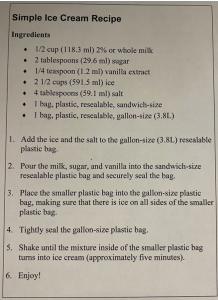
Monday: Good evening SAVY students and parents! We are off to a great start learning there’s more to technology than a computer screen. Many humans spend of 95% of their time interacting with technology. Pencils, chairs, water filters, toothbrushes, cell phones, and buildings are all technologies. We defined technology as solutions designed by engineers to fulfill human need or wants. We talked about the various fields of engineering and defined what engineers do. Students were given a brown paper bag with a technology inside. Each group looked at the object inside and describe how that technology had been created to solve a problem. Items included a stapler, tape, paper clips, and a pencil sharpener. We discussed how these items had been created to make a part of our lives easier.
Next, we read the story Aisha Makes Work Easier. As we read through the story, we stopped throughout the book to record examples of simple machines discussed in the story. After learning the various types of simple machines (lever, pulley, wheel & axle, inclined plane, wedge, and screw) we took a nature walk around the campus to identify everyday objects made by people as technology. Vocabulary terms were defined, and we play a musical game that would add an instrument, to the musical beat that was playing, each time we answered three questions in a row correctly.
Tomorrow will be all about evaluating the advantages and disadvantages of performing many steps in a process on your own. We will discover more ways that technology makes life easier for us!


